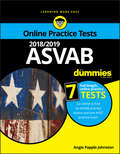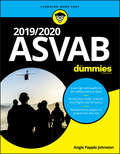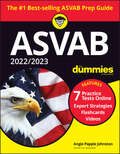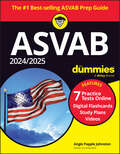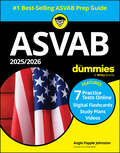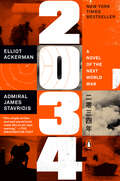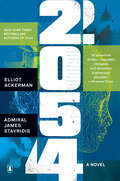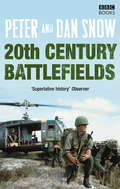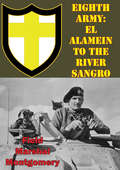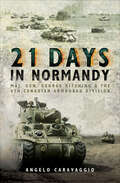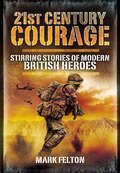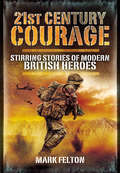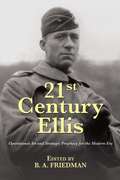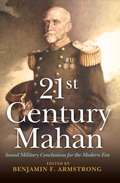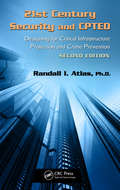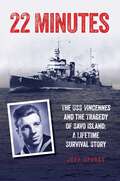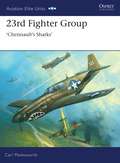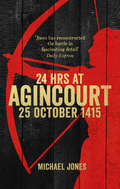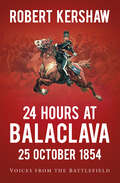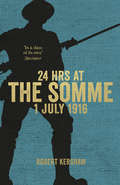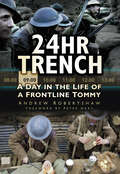- Table View
- List View
2018/2019 ASVAB For Dummies with Online Practice
by Angie Papple JohnstonAce the ASVAB with this easy to use guide—including online practice! Looking to join the military and get the job of your dreams? Before your boots hit the ground, you’ll have to perform on the ASVAB to qualify for military participation and for specialty placement. 2018/2019 ASVAB For Dummies with Online Practice provides you with in-depth reviews of the nine test subjects to get you going, along with complete explanations for each question, exercises, strategy cheat sheets, and tips to discover your weaknesses and work to maximize your test performance. You’ll also be able to go online to study whenever you like, with convenient resources, hundreds of flashcards, 6 full-length ASVAB practice tests, and one AFQT practice test that will help you tailor your studying to suit your specific needs. If you’ve always dreamed of joining the military and being challenged by a new and exciting career, the ASVAB is your first step to achieving your dreams, and this guide will help you along the way! Aim high, score high on the ASVAB and qualify for the military job you want Quickly boost your math, science, and English performance for the test Complete an in-depth review of all 9 subject areas to prepare for that crucial test day Study hard and get the score that will help you get an enlistment bonus 2018/2019 ASVAB For Dummies with Online Practice is your go-to guide for mastering the skills and knowledge you’ll need to attain the ASVAB test score that will help you live your dream!
2019/2020 ASVAB For Dummies
by Angie Papple JohnstonThe bestselling ASVAB study guide—now updated and improved for 2019/2020! More than 1 million students and potential recruits take the ASVAB every year, including 400,000 recruits and 900,000 high school students. Since the test was first introduced in 1968, more than 40 million people have taken the exam. 2019/2020 ASVAB For Dummies is packed with practice questions, an in-depth review of each of the nine subtests, strategy cheat sheets, proven study tips, and so much more. New for this edition, potential recruits will find expanded math coverage, with more content review and practice questions for the Math Knowledge and Arithmetic Reasoning sections of the exam. Score high and qualify for the military job you want Boost your math, science, and English performance Review all nine subject areas to prepare for test day Take three full-length ASVAB practice tests and two AFQT practice tests If you’re preparing for this all-important exam, this hands-on study guide makes it easier than ever to take your military career to new heights.
2021 / 2022 ASVAB For Dummies: Book + 7 Practice Tests Online + Flashcards + Video
by Angie Papple JohnstonOwn the ASVAB test with the #1 guide on the market! Passing the ASVAB test is the essential ticket to getting into your dream branch of the military—and a good score can determine the shape of your career. A stellar performance can also help you get grants and bonuses for school, so—no pressure! But don't be daunted: like any military operation, having the right plan of attack and equipment are key—and as the number-one-selling guide year after year that's packed with all the information you need to win, the latest edition ASVAB For Dummies takes care of both of these in one! In a friendly, straightforward style, Angie Papple Johnston—who passed the test herself in 2006 to join the Army—provides in-depth reviews of all nine test subjects. Don't worry if you slept through some of this material in school; you’ll find a complete refresher on everything you'll be expected to know—plus full explanations for every answer, drill exercises, and strategy cheat sheets for verbal, math, and general sciences. You'll also get tips on how to pinpoint areas where you need to develop mental muscle and to strengthen your test-taking skills. And if this weren't already giving you some pretty awesome firepower, you can also go online to reinforce your game using flashcards and customizable practice tests calibrated to address areas where you need help the most. Match your skills against practice problems Drill your math, science, and English knowledge to perfection Master test strategy and tactics Get one-year access to additional practice tests, flashcards, and videos online Whatever your aim for your military career, this book provides the perfect training ground for you to be the very best you can be on the day of the test!
2022 / 2023 ASVAB For Dummies: Book + 7 Practice Tests Online + Flashcards + Video
by Angie Papple JohnstonLock down the score you need to get the job you want! The bestselling ASVAB For Dummies is back with an updated and expanded annual edition. Joining the military? Want to maximize your score and your job flexibility? Dummies to the rescue! With 2022/2023 ASVAB For Dummies, you’ve got access to an insane amount of test prep and study material, including 7 online practice tests, flashcards, hundreds of practice questions right in the book, and a lot more. Military recruiters trust the #1 Bestselling ASVAB study guide on the market to help their prospective enlistees score high on the test. Check out these insider tips and tricks for test-day-success from an expert author, and practice with example problems until you feel confident. Learn at your own pace. It’s all possible. Next stop: basic training. Learn what the ASVAB is all about, including all 10 test sections Practice with 7 online practice tests and countless more questions Identify the score you need to get the job you want—then get that score Work through at your own pace and emphasize the areas you need ASVAB For Dummies is a reliable study guide with proven results. You don’t need anything else. Get studying, recruit!
2023 / 2024 ASVAB For Dummies (+ 7 Practice Tests, Flashcards, & Videos Online)
by Angie Papple JohnstonMaximize your ASVAB score and maximize your military job flexibility If you want to join the military, you have to take the ASVAB. And if you want the flexibility to apply for a specific job, you’ll need right the score to get it! The 2023/2024 edition of ASVAB For Dummies has everything you need to prep for the exam and get the score you need to land the job you want: content review, study questions, practice exams in the book and online, digital flashcards, instructional videos, and practical tips for exam day. This bestselling ASVAB study guide is back, with everything you need to know about this year’s test, plus customizable test prep plans so you can make your study time count, right up to ASVAB day. Brush up on all 10 subject areas, including science, arithmetic, and electronics. Then, look to the easy-to-use online resources in this to activate your knowledge and launch your military career. Access hundreds of practice questions, full-length practice tests, instructional videos, and digital flashcards online Create a study schedule that works for you, and maximize your ASVAB score Show the military that you’re capable and ready to get started in your dream job Learn at your own pace and get tips for keeping your nerves in check on test dayIf you’re taking the ASVAB this year – or this week -- you need this reliable Dummies study guide—it brings results.
2024/2025 ASVAB For Dummies: Book + 7 Practice Tests + Flashcards + Videos Online
by Angie Papple JohnstonGet the score you need to get the job you want! The bestselling ASVAB For Dummies is back with an updated and expanded annual edition. This trusted study guide will help you succeed on the essential military recruitment test. Now with more examples, walk-throughs, and practice questions, you can land the score that will qualify you for your preferred military job. With practice tests in the book and online, videos, and hundreds of digital flashcards, this Dummies resource is perfect for all things ASVAB. Trusted by military recruiters across the country, this book also includes insider tips and tricks for test-day-success. Study at your own pace and make your dreams possible with ASVAB For Dummies. Learn from simple explanations of all the content covered on the ASVAB, plus tons of resources for studying Follow detailed study plans that will help you prepare 12 weeks, 6 weeks, 4 weeks, or 1 week before the test Take practice tests and work through detailed answer explanations to improve your score Get even more practice online, with practice tests, flashcards, and videos For years, ASVAB For Dummies has been helping recruits launch their military careers right. Now, it's your turn.
2025/2026 ASVAB For Dummies: Book + 7 Practice Tests, Flashcards, and Videos Online
by Angie Papple JohnstonScore high on the ASVAB and launch your military career! The latest edition of ASVAB For Dummies is here, packed with content to guide you through the military's aptitude test in 2025/2026. Whether you're aiming for a top-tier job or just need to secure that qualifying score, this book's got you covered. With expanded content on paragraph comprehension and more science practice questions than ever before, this test prep guide will help you do your best on test day. Plus, you'll get full access to online practice tests, digital flashcards, and videos to boost your confidence. Recommended by recruiters nationwide, ASVAB For Dummies shares insider strategies to help you excel when it counts. Clear, straightforward explanations of every ASVAB section, with plenty of tools to help you study smarter New information on Space Force career paths Full-length practice tests with detailed answers, so you can learn from your mistakes and raise your score Instructional videos, hundreds of practice questions, and digital flashcards online ASVAB For Dummies has been the go-to resource for military hopefuls for years—now it's your chance to get ahead!
2034: A Novel of the Next World War
by Elliot Ackerman Admiral James StavridisFrom two former military officers and award-winning authors, a chillingly authentic geopolitical thriller that imagines a naval clash between the US and China in the South China Sea in 2034--and the path from there to a nightmarish global conflagration. <P><P>On March 12, 2034, US Navy Commodore Sarah Hunt is on the bridge of her flagship, the guided missile destroyer USS John Paul Jones, conducting a routine freedom of navigation patrol in the South China Sea when her ship detects an unflagged trawler in clear distress, smoke billowing from its bridge. On that same day, US Marine aviator Major Chris "Wedge" Mitchell is flying an F35E Lightning over the Strait of Hormuz, testing a new stealth technology as he flirts with Iranian airspace. By the end of that day, Wedge will be an Iranian prisoner, and Sarah Hunt's destroyer will lie at the bottom of the sea, sunk by the Chinese Navy. Iran and China have clearly coordinated their moves, which involve the use of powerful new forms of cyber weaponry that render US ships and planes defenseless. In a single day, America's faith in its military's strategic pre-eminence is in tatters. A new, terrifying era is at hand. <P><P>So begins a disturbingly plausible work of speculative fiction, co-authored by an award-winning novelist and decorated Marine veteran and the former commander of NATO, a legendary admiral who has spent much of his career strategically outmaneuvering America's most tenacious adversaries. Written with a powerful blend of geopolitical sophistication and human empathy, 2034 takes us inside the minds of a global cast of characters--Americans, Chinese, Iranians, Russians, Indians--as a series of arrogant miscalculations on all sides leads the world into an intensifying international storm. In the end, China and the United States will have paid a staggering cost, one that forever alters the global balance of power. Everything in 2034 is an imaginative extrapolation from present-day facts on the ground combined with the authors' years working at the highest and most classified levels of national security. Sometimes it takes a brilliant work of fiction to illuminate the most dire of warnings: 2034 is all too close at hand, and this cautionary tale presents the reader a dark yet possible future that we must do all we can to avoid. <P><P><b>A New York Times Bestseller</b>
2054: A Novel
by Elliot Ackerman Admiral James Stavridis USNFrom the acclaimed authors of the runaway New York Times bestseller 2034 comes another explosive work of speculative fiction set twenty years further in the future, at a moment when a radical leap forward in artificial intelligence combines with America&’s violent partisan divide to create an existential threat to the country, and the worldIt is twenty years after the catastrophic war between the United States and China that brought down the old American political order. A new party has emerged in the US, one that&’s held power for over a decade. Efforts to cement its grip have resulted in mounting violent resistance. The American president has control of the media, but he is beginning to lose control of the streets. Many fear he&’ll stop at nothing to remain in the White House. Suddenly, he collapses in the middle of an address to the nation. After an initial flurry of misinformation, the administration reluctantly announces his death. A cover-up ensues, conspiracy theories abound, and the country descends into a new type of civil war.A handful of elite actors from the worlds of computer science, intelligence, and business have a fairly good idea what happened. All signs point to a profound breakthrough in AI, of which the remote assassination of an American president is hardly the most game-changing ramification. The trail leads to an outpost in the Amazon rainforest, the last known whereabouts of the tech visionary who predicted this breakthrough. As some of the world&’s great powers, old and new, state and nonstate alike, struggle to outmaneuver one another in this new Great Game of scientific discovery, the outcome becomes entangled with the fate of American democracy.Combining a deep understanding of AI, biotech, and the possibility of a coming Singularity, along with their signature geopolitical sophistication, Elliot Ackerman and Admiral James Stavridis have once again written a visionary work. 2054 is a novel that reads like a thriller even as it demands that we consider the trajectory of our society and its potentially calamitous destination.
20th Century Battlefields
by Dan Snow Peter SnowIn this riveting book, political journalist Peter Snow and military historian Dan Snow bring to life the most intense and bitterly fought battles of the 20th century - from the apocalyptic terrain of the Western Front to the desert landscape of Iraq. Punctuated by powerful eyewitness testimony, their compelling and often shocking narrative highlights the strategy of military commanders as well as the experience of men on the frontline. 20th Century Battlefields looks back at the most violent century in history and examines the challenges facing armed forces in the future.
21 Army Group: Normandy To The Baltic [Illustrated Edition] (Memoirs Of Field Marshal Montgomery #1)
by Field Marshal Viscount Bernard Law Montgomery of Alamein KG GCB DSO PC[Illustrated with 46 highly detailed maps of the actions]Field Marshal Montgomery commanded the Eighth Army from 13th August 1942 until the 31st December 1943, and the 21st Army Group from 1st January 1944 until the German surrender on the 5th May, 1945. Whilst in command of the British Army of the Rhine, in occupation of Germany, shortly after the end of the Second World War Montgomery set out to record the exploits and victories of the troops under his command.Both this volume and its companion volume, El Alamein to the River Sangro, are superb examples of military history as presented by one of the greatest generals to command victorious armies in the field. The texts are taken from his personal war diaries and are distinguished by his incisive style. The whole strategy and course of these two campaigns are presented to the reader with great clarity and accuracy.In Normandy to the Baltic the Field Marshal unfolds that greater task -- the planning and implementation of the greatest invasion the world has ever known -- Operation Overlord. He describes the whole plan behind. D Day and the Battle of Normandy. He continues with the battle for Caen and the capture of Cherbourg, the closing of the Falaise Pocket and the crossing of the Seine--through into the Low Countries and the Battle of Arnhem and the famous Battle of the Ardennes. He concludes with the battle of the Rhineland, the crossing of the Rhine and the rush across northern Germany to the final surrender. The whole pattern of the complex allied effort -- British, Canadian and American -- is described with extraordinary detail and each episode is analysed in retrospect.
21 Days in Normandy: Maj. Gen. George Kitching & the 4th Canadian Armoured Division
by Angelo Caravaggio&“Right[s] some of the injustices done to the Canadians&” on their maligned actions during the Invasion of Normandy. &“An absorbing account&” (Firetrench). The Canadian Fourth Armoured Division crossed the Channel in July 1944 to support the invading forces and assist in the Allied attempts to break out of the Normandy beachhead. They were heavily engaged in Operation Totalize and Operation Tractable but have been criticized for their failure to close the &‘Falaise gap&’ and complete the entrapment of withdrawing German forces. Their commander, Major General George Kitching, was relieved of his command after just twenty-one days in action. Angelo Caravaggio reexamines the division&’s performance and particularly that of its leadership. Using new information, he establishes that, despite entering battle for the first time during one of the most challenging phases of Allied operations in August 1944, the 4th Armoured Division, under Kitching&’s leadership, proved resilient and adaptive in overcoming the volatile and unpredictable nature of warfare in Normandy. The combat operations of August 1944 transformed the division into a battle-hardened combat formation that would later distinguish itself through its ability to generate a sustained drive across France out of the chaos and destruction of the Normandy battles. &“The author uses new information to demonstrate the unit did show flexibility and adapted to the battlefield quickly, despite being thrown into battle during one of the Normandy Campaign&’s critical phases. His arguments are detailed and based upon in-depth research, and the book has many detailed maps to help the reader follow the action.&” —Warfare History Network
21st Century Courage: Stirring Stories of Modern British Heroes
by Mark FeltonThe book examines examples of outstanding courage exhibited by people living in modern Britain. These include British servicemen and servicewomen serving in Iraq and Afghanistan, police officers, and ordinary civilians in Britain and around the world. All of the cases cited have been awarded gallantry medals by the British government since 2000.The purpose of the book is to inspire modern British people. In the past, the heroes of Empire were well-known and respected, but since the Second World War people have tended to associate heroism with celebrity instead. We hear footballers and actors described as heroes, and this demeans the word, and the real heroes of modern British society. The generations that fought the First and Second World Wars have often been held up as the greatest generations of British people. This book shows Britons that the kind of grit, determination, courage and willingness to have a go exhibited by previous generations are as alive now as they ever were, and heroes can come from all walks of life and all ethnic groups in modern Britain.
21st Century Courage: Stirring Stories of Modern British Heroes
by Mark FeltonThe book examines examples of outstanding courage exhibited by people living in modern Britain. These include British servicemen and servicewomen serving in Iraq and Afghanistan, police officers, and ordinary civilians in Britain and around the world. All of the cases cited have been awarded gallantry medals by the British government since 2000.The purpose of the book is to inspire modern British people. In the past, the heroes of Empire were well-known and respected, but since the Second World War people have tended to associate heroism with celebrity instead. We hear footballers and actors described as heroes, and this demeans the word, and the real heroes of modern British society. The generations that fought the First and Second World Wars have often been held up as the greatest generations of British people. This book shows Britons that the kind of grit, determination, courage and willingness to have a go exhibited by previous generations are as alive now as they ever were, and heroes can come from all walks of life and all ethnic groups in modern Britain.
21st Century Ellis
by Edited by B. A. FriedmanFor years, the Marine Corps has touted the prescience of Lieutenant Colonel "Pete” Ellis, USMC, who predicted in 1921 that the United States would fight Japan and how the Pacific Theater would be won. Now, for the first time, those predictions and other works by the "amphibious prophet” are available in print. Included is two works by Ellis on naval and amphibious operations, including Advanced Base Operations in Micronesia, the study of tactics and operations in the Pacific Ocean that the United States Navy and Marine Corps would use to win the war against Imperial Japan. Ellis describes the form and functions of a modern Marine Corps designed to win its Nation’s battles. Ellis’ ideas about how the Marine Corps should fight are still in use throughout the world today. Ellis’ ideas on amphibious operations are well known, but his ideas on counterinsurgency and conventional war have been overshadowed and forgotten. Ellis wrote two articles based on his warfighting experiences in the Philippines and as part of the American Expeditionary Force in Europe during World War I. These articles, last published in the early 1920’s, are both republished in this book and show Ellis as a prescient thinker who was ahead of his time. Ellis identifies concepts that the U. S. military struggles with even today, and that other thinkers would not identify for decades after Ellis’ death. Also included are six essays by the editor, introducing the ideas of Pete Ellis and putting them in a modern context. As the United States turns its focus to the Pacific, Ellis’ ideas can inform policymakers on the dynamics of strategy and warfare in the vast reaches of the Pacific Ocean. Edited by Captain B. A. Friedman, USMC, 21st Century Ellis reveals the strategic insights of Pete Ellis for then and now.
21st Century Mahan
by Benjamin ArmstrongAlfred Thayer Mahan's The Influence of Seapower upon History is well known to students of naval history and strategy, but his other writings are often dismissed as irrelevant to today's problems. This collection of five of Mahan's essays, along with Benjamin Armstrong's informative introductions, illustrates why Mahan's work remains relevant to the 21st century and how it can help develop our strategic thinking. People misunderstand Mahan, the editor argues, because they have read only what others say about him, not what Mahan wrote himself. Armstrong's analysis is derived directly from Mahan's own writings. From the challenges of bureaucratic organization and the pit falls of staff duty, to the development of global strategy and fleet composition, to illustrations of effective combat leadership, Armstrong demonstrates that Mahan's ideas continue to provide today's readers with a solid foundation to address the challenges of a rapidly globalizing world.
21st Century Security and CPTED: Designing for Critical Infrastructure Protection and Crime Prevention, Second Edition
by Randall I. AtlasThe concept of Crime Prevention Through Environmental Design (CPTED) has undergone dramatic changes over the last several decades since C. Ray Jeffery coined the term in the early 1970s, and Tim Crowe wrote the first CPTED applications book. The second edition of 21st Century Security and CPTED includes the latest theory, knowledge, and practice of
21st Century Sims
by Edited by Benjamin F. ArmstrongFor more than two decades at the beginning of the 20th century William S. Sims was at the forefront of naval affairs. From the revolution in naval gunnery that he led as a junior officer, to his advocacy for the Dreadnaught style all-big-gun battleship, to his development of torpedo boat and destroyer operations, he was a central figure in helping to prepare the U. S. Navy for World War I. During the war he served as the senior naval commander in Europe and was instrumental in the establishment of the convoy system that won the Battle of the Atlantic. Following the war his leadership as President of the Naval War College established the foundations of the creative and innovative Navy that would develop the operating concepts for submarines and aircraft carriers which would lead to success in World War II. Despite his dramatic impact on the U. S. Navy in the first half of the 20th century, Sims is a relatively unknown figure today. Overshadowed in our memory by the World War II generation of strategic Admirals, like Chester Nimitz and Raymond Spruance, he receives little attention from historians or professional naval officers. Despite the fact that he won a Pulitzer Prize for history, hardly anyone reads the books or articles he left as his legacy. This collection of six essays written by Sims illustrates why his thinking and leadership are relevant to the challenges faced in the 21st century. From the perils of military conservatism, to the responsibilities of the professional officer, to military downsizing and reform, he helped lay the foundations of the modern Navy. Armstrong’s introductions and analysis of these essays links them directly to the issues of innovation, professional education, and leadership that are as important at the start of this century as they were at the start of the last.
22 Minutes: The USS Vincennes and the Tragedy of Savo Island: A Lifetime Survival Story
by Jeff SpevakErnie Coleman survived the worst open-sea defeat in US Navy history. But he paid a price and buried the horrific memories for decades.In the manner of Mitch Albom&’s highly successful Tuesdays with Morrie, 22 Minutes is a searing account of a survivor coming to terms with an incident he had suppressed for sixty years and the writer who painstakingly put together the clues about what had happened.Author Jeff Spevak was confronted with a dilemma: How do you tell the story of a man who can&’t bring himself to talk about the most epic moment of his life? A clever fellow who&’d scrapped to survive in a fashion that seems quaint today, Coleman tested himself as a teenager by swimming across lakes, building homes from foraged lumber, running a Navy carpentry shop as though he were a member of the scamming crew of McHale&’s Navy. He was a self-taught sailor who&’d become a legend on Lake Ontario. At age 96, Ernie was still sailing.Ernie Coleman talked of his life frankly – his honest remembrances of brawls and regrets. But he refused to talk about the one thing that had haunted him for decades: the sinking of his ship the Vincennes and his nightmares of men screaming in the burning sea, of incinerated corpses still manning the anti-aircraft guns. Through interviews with Coleman's family and others who knew Coleman, and arduous research Spevak finally put together what had occurred the night of the horrendous loss of his ship, the USS Vincennes, a cruiser sunk during the World War II Battle of Savo Island off Guadalcanal. Four big ships and more than 1,000 sailors were lost that night in a 22-minute battle, the worst open-sea defeat in the history of the United States Navy.Gripping, moving, highly personal, 22 Minutes is Coleman&’s story of the incident he had buried for more than 60 years. Did Ernie pursue sailing with such intensity, at a time when most men his age are sitting in front of the television, waiting for the end, so that he did not have to close his eyes and remember that night on the Vincennes?&“I know why those kids come back from Afghanistan and shoot themselves,&” he said sadly one morning, sitting on the shady patio at his home. &“You lay awake at night, reacting, reacting, reacting. Because it&’s so real.&”22 Minutes has enormous potential to match some of the best-selling first-hand World War II memoirs published in recent years.
23 Years on Fire: A Cassandra Kresnov Novel (Cassandra Kresnov Ser.)
by Joel ShepherdCassandra Kresnov--a highly advanced hunter-killer android--returns to face down a rogue government's plot to eliminate free will. Commander Cassandra Kresnov has her hands full. She must lead an assault against the Federation world of Pyeongwha, where a terrible sociological phenomenon has unleashed hell against the civilian population. Then she faces the threat from a portion of League space known as New Torah, in which a ruthless regime of surviving corporations are building new synthetic soldiers but taking the technology in alarming directions. On the Torahn world of Pantala, Sandy encounters betrayal, crisis, and conspiracy on a scale previously unimaginable. Most challenging of all, she also meets three young street kids who stir emotions in her she didn't think she was capable of. Can the Federation's most lethal killer afford unexpected sentiment? What will be the cost if she is forced to choose between them and her mission, not only to her cause, but to her soul?
23rd Fighter Group
by Jim Laurier Carl MolesworthStaffed with inexperienced USAAF pilots and led by a handful of seasoned veterans of the American Volunteer Group (AVG), the 23rd FG was formed in the field at Kunming, in China, on July 4, 1942 and flew combat missions that same day. The group's three squadrons - the 74th, 75th and 76th Fighter Squadrons - were initially equipped with war-weary P-40s handed down from the AVG. These were supplemented by the attached 16th FS, flying new P-40Es, and all squadrons adorned the noses of their airplanes with fearsome and iconic sharksmouth designs.The 23rd FG fought a guerrilla war against the Japanese, steadily moving pilots and aircraft from one remote air base to another to keep the enemy off balance. Because China could only be supplied by air from India, there were constant shortages of aircraft, fuel and ammunition with which to contend. The 23rd FG met these challenges head-on and by the end of the war its pilots had compiled a score of 594 aerial victories and nearly 400 ground kills. Among the 47 aces who flew in the 23rd were colorful characters such as David L 'Tex' Hill, Robert L 'Bob' Scott and Clinton D 'Casey'. The human cost was high, however - 126 pilots lost their lives in China while serving in the 23rd.
24 Hours at Agincourt
by Michael JonesAgincourt was an astonishing clash of arms, a pivotal moment in the Hundred Years War and the history of warfare in general.King Henry V’s exhausted troops were preparing for certain defeat as they faced a far larger French army. What was to take place in the following 24 hours, it seemed only the miraculous intervention of God could explain.Interlacing eyewitness accounts, background chronicle and documentary sources with a new interpretation of the battle’s onset, acclaimed military historian Michael Jones takes the reader into the heart of this extraordinary feat of arms.
24 Hours at Balaclava: Voices from the Battlefield
by Robert KershawIn 1854 Britain and France were at war to save ‘poor little Turkey’, the crumbling Ottoman Empire, from the menace of Russian expansionism. On 25 October they were nine days into what would become an eleven-month siege, with little to show for it. Suddenly, from behind them came the unmistakeable sound of cannon. The Russians had arrived. Vastly outnumbered, the British gained an unlikely upper hand with the charge of the Heavy Brigade and the efforts of the Thin Red Line. But then, within two hours of achieving near victory, the British squandered it in dramatic style with the charge of the Light Brigade. Using eyewitness accounts, letters and diaries, acclaimed military historian Robert Kershaw presents a new, intimate look at the Battle of Balaclava, from the perspective of the men who ‘saw little and knew even less’. Come down from the Heights and see the real story of one of the most ill-fated military expeditions in British history.
24 Hours at the Somme: 1 July 1916
by Robert KershawThe first day of the Somme has had more of a widespread emotional impact on the psyche of the British public than any other battle in history. Now, 100 years later, Robert Kershaw attempts to understand the carnage, using the voices of the British and German soldiers who lived through that awful day.In the early hours of 1 July 1916, the British General staff placed its faith in patriotism and guts, believing that one ‘Big Push’ would bring on the end of the Great War. By sunset, there were 57,470 men – more than half the size of the present-day British Army – who lay dead, missing or wounded. On that day hope died.Juxtaposing the British trench view against that from the German parapet, Kershaw draws on eyewitness accounts, memories and letters to expose the true horror of that day. Amongst the mud, gore and stench of death, there are also stories of humanity and resilience, of all-embracing comradeship and gritty patriotic British spirit. However it was this very emotion which ultimately caused thousands of young men to sacrifice themselves on the Somme.
24hr Trench: A Day in the Life of a Frontline Tommy
by Andrew RobertshawThe trench was the frontline Tommy’s home. He lived, ate, slept, and sometimes died in this narrow passage amongst the slime of mud and blood on the Western Front. His washbasin was a mess-tin, his cooker – a small fire built into the wall, his entertainment – his friends, his fear – the man living in the trench on the other side of No Man’s Land. Over 6 million men died whilst serving in the trenches – how did they live in them? For the first time, World War I historian Andrew Robertshaw and a group of soldiers, archaeologists and historians use official manuals and diaries to build a real trench system and live in it for 24 hours, recreating the frontline Tommy’s daily existence, answering the questions: How do you build a trench quietly? How clean can you really get in a trench? How easy is it to sleep? How do you keep yourself entertained? How to do you stay alive and kill the enemy? And many more… Hour-by-hour, the Tommy’s day unfolds through stunning colour photographs in this ground-breaking experiment in Great War history.
